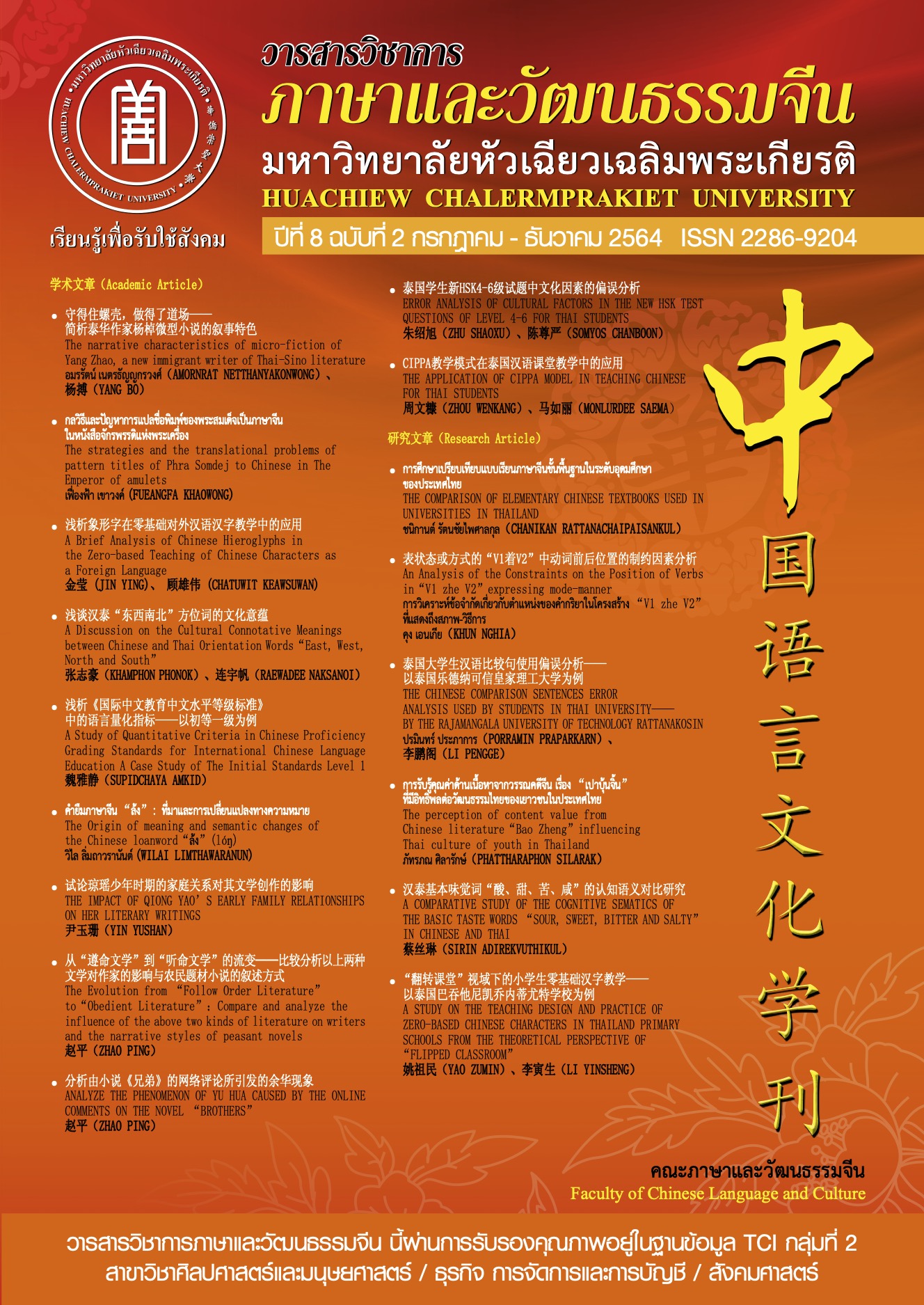A Study of Quantitative Criteria in Chinese Proficiency Grading Standards for International Chinese Language Education A Case Study of The Initial Standards Level 1
Keywords:
Standards for International Chinese Language Education, The Initial Standard, Vocabulary, HSK, ComparisonAbstract
The objectives of this study are as follows: 1) to study and analyze quantitative criteria in Chinese Proficiency Grading Standards for International Chinese Language Education. The quantitative criteria consist of a syllable table, a Chinese character table, Chinese grammar table and a vocabulary table. The samples of this study selected only the syllable table, the Chinese character table, and the vocabulary table of the initial standards Level 1.; 2) to compare the similarities and differences between the three tables of the Initial Standard Level 1 and the vocabulary tables of the HSK exams from Levels 1-3.The results revealed as follows: 1) the syllable table, the Chinese character table, and the vocabulary table of the Initial Standard Level 1 were related, but the researcher found that some syllables that appeared in the syllable table were not in the vocabulary table. Additionally, there was some problem directing the parts of speech in some words as well; 2) the vocabulary in the vocabulary table of the Initial Standard Level 1 exceeds the volume and scope of the HSK(Level 1). Compared to the HSK(Level 2), the syllables and the Chinese characters have the same higher proportion, but the vocabulary aspect still exceeds the HSK(Level 2). Compared to HSK(level 3), the same proportion of the syllables, the Chinese characters, and the vocabulary increased. Still, it turns out that HSK(Level 3) has a volume and scope of all three aspects that significantly exceed the Initial Standard Level 1.
Keywords: The standard, The Initial Standard, Vocabulary, HSK, Comparison
References
马春雨.(2018).汉语水平考试的研究现状与文献特征.[J].语言应用研究,(4),105-110.
尹春梅.(2008).《汉语水平词汇与汉字等级大纲》问题研究综述.[J].乌鲁木齐成人教育学院学报,
(3):35-37.
中国社会科学院语言研究所词典编辑室.现代汉语词典.[M].北京:商务印书馆,2016:815-816.
中国政府网.中国以外累计学习中文人数达2亿“中文联盟”等国际中文在线教育平台发布
[Online](http://www.gov.cn/xinwen/2020-09/05/content_5540872.htm),2021/05/28
中华人民共和国教育部.《汉语国际能力标准》简介[Online]
(http://www.moe.gov.cn/srcsite/zsdwxxgk/200710/t20071031_61879.html),2021/04/15
中华人民共和国教育部. 以《标准》建设提升国际中文教育质量——教育部中外语言交流合作中
心负责人答记者问[Online]
(http://www.moe.gov.cn/jyb_xwfb/s271/202104/t20210402_524194.html),2021/04/15
中华人民共和国教育部.《国际中文教育中文水平等级标准》发布[Online]
(http://www.moe.gov.cn/jyb_xwfb/gzdt_gzdt/s5987/202103/t20210329_523304.html),
/03/31
央视网.国外学习使用汉语的人数已超过1亿[Online]
(http://news.cctv.com/2017/10/28/ARTIUuIlgFPLlWKv25vXJ6Lm171028.shtml),
/05/28
刘珣.新实用汉语课本1.[M].北京:北京语言大学出版社,2002.
刘英林,郭树军,王志芳.(1988).汉语水平考试(HSK)的性质和特点. [J].世界汉语教学,(2),
-120.
孙佳.(2013).新汉语水平考试(HSK)效度问题研究.[D]. 硕士学位论文.吉林大学.
张广冬(2017).汉语水平考试真题词汇与大纲词汇对比研究.[D].硕士学位论文.上海师范大学.
张晋军,解妮妮,王世华,李亚男,张铁英.(2010).新汉语水平考试(HSK)研制报告.[J].中国考试,(9),
-43.
张新生,李明芳.(2019).汉语能力标准比较初探.[J].国际汉语教学研究,(1):33-49.
杨承青、张晋军.(2007).汉语水平考试(HSK)改革设想. [J]. 语言文字应用,(3),107-112.
何平.汉语语音教程•基础篇.[M].北京:北京大学出版社,2006.
周丽.(2016).新HSK大纲及试题研究.[D].硕士学位论文.黑龙江大学.
国家汉办/孔子学院总部. 新汉语水平考试大纲HSK一级.[M].北京:商务印书馆,2009.
国家汉办/孔子学院总部. 新汉语水平考试大纲HSK二级.[M].北京:商务印书馆,2009.
国家汉办/孔子学院总部. 新汉语水平考试大纲HSK三级.[M].北京:商务印书馆,2009.
黄伯荣,廖序东.现代汉语.上册.[M].北京:高等教育出版社,2007:135.
崔蕾.(2012).新旧HSK考试大纲对比研究与全项应试辅导—以旧HSK(基础)和新HSK(4级)为例.[D].
硕士论文.河北师范大学.
阚铮.(2014).HSK新旧大纲之比较分析—以新三级试题为例.[D].硕士学位论文.鲁东大学.
OKLS.คุณครูสอนภาษาจีน[Online](https://www.okls.net/cn/联系我们/与okls合作),2021/05/28
งานภาษาจีน Chinese Jobs. 急招聘秘书&助理 [Online]
(https://www.facebook.com/photo?fbid=3872280272829871&set=gm.1376545932697648_),
/05/28
Downloads
Published
How to Cite
Issue
Section
License
บทความที่ได้รับการตีพิมพ์เป็นลิขสิทธิ์ของวารสารภาษาและวัฒนธรรมจีน มหาวิทยาลัยหัวเฉียวเฉลิมพระเกียรติ
บทความใน “วารสารวิชาการภาษาและวัฒนธรรมจีน” เป็นทรรศนะของผู้เขียนโดยเฉพาะ กองบรรณาธิการไม่มีส่วนในความคิดเห็นในข้อเขียนเหล่านั้น




